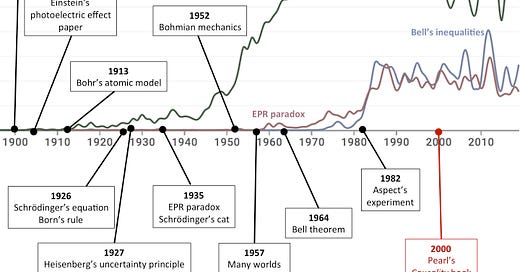Arguably the first physical theory to make use of probabilistic and statistical concepts as fundamental building blocks was quantum mechanics. Probabilistic reasoning had been around for a few centuries before that, and statistical considerations had already been applied to physics, for instance by Ludwig Boltzmann – the father of statistical mechanics. But in quantum mechanics, such reasoning is not merely a convenient way to tackle otherwise intractable problems: it is a core aspect of the theory itself.
It is thus surprising that modern statistics does not predate quantum mechanics. For instance, Ronald Fisher’s seminal contributions span from 1919 to 1956, while quantum mechanics in the Copenhagen interpretation was arguably complete by 1927, when the fifth Solvay conference was held.
In 1951 Edward Simpson described a statistical paradox that stayed unresolved until tools to describe causality were added to our statistical vocabulary largely thanks to the work of Judea Pearl. This happened in the mid 1990s and was summarised in the book Causality: models, reasoning, and inference published in 2000. The entire development of quantum mechanics -including the vigorous debate on its foundations culminating in the experiments by Alain Aspect which confirmed the violation of Bell’s inequalities in 1982- happened before that.
Graph from Google n-gram viewer showing the number of occurrences of relevant sentences and some of their variations over time in the English corpus from Google books. Important milestones in the development of quantum mechanics added manually by me.
It may be worth pausing here to ponder that throughout the entirety of quantum mechanics’s development, physicists had no formal way to express the presence of a causal dependence as opposed to mere statistical correlation between two variables.
Besides developing a convenient mathematical formalism for reasoning about causal relations, Pearl’s work introduces the notion of causality as independent and perhaps more fundamental than statistical association. This point of view smells of metaphysics to anyone who absorbed the empiricist mindset of modern physics. Not to mention that he writes (Causality, sect. 14. page 26):
In this book, we shall express preference toward Laplace's quasi-deterministic conception of causality and will use it [...] the Laplacian conception is more in tune with human intuition. The few esoteric quantum mechanical experiments that conflict with the predictions of the Laplacian conception evoke surprise and disbelief, and they demand that physicists give up deeply entrenched intuitions about locality and causality (Maudlin 1994). Our objective is to preserve, explicate, and satisfy - not destroy - those intuitions.
This seems a deliberate choice to develop a classical theory of causality, one where you can freely imagine counterfactuals. It is certainly not borne out of ignorance, given that Pearl contributed to superconductivity theory, having thus been certainly abundantly exposed to quantum mechanics. He is essentially choosing not to engage with the foundations of quantum mechanics.
But we can pick up the baton where he dropped it. If nothing else, history suggests that attempting to cross-fertilise quantum mechanical concepts with the new science of causality may result in breakthroughs in either field.




